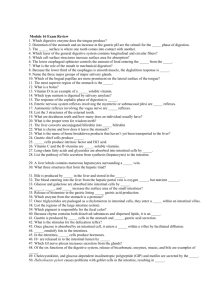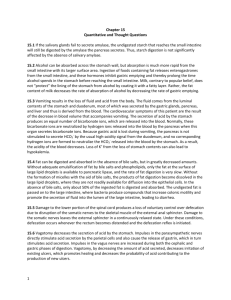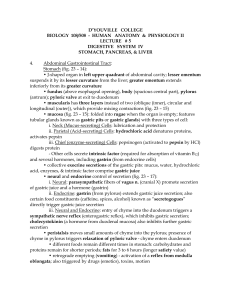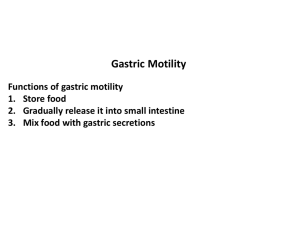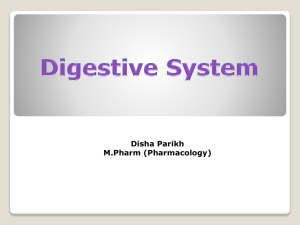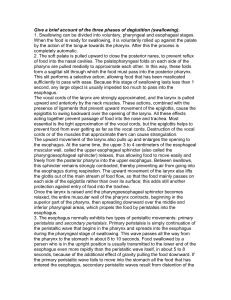Questions : RAD223 Q1- Define the following terms: a
advertisement
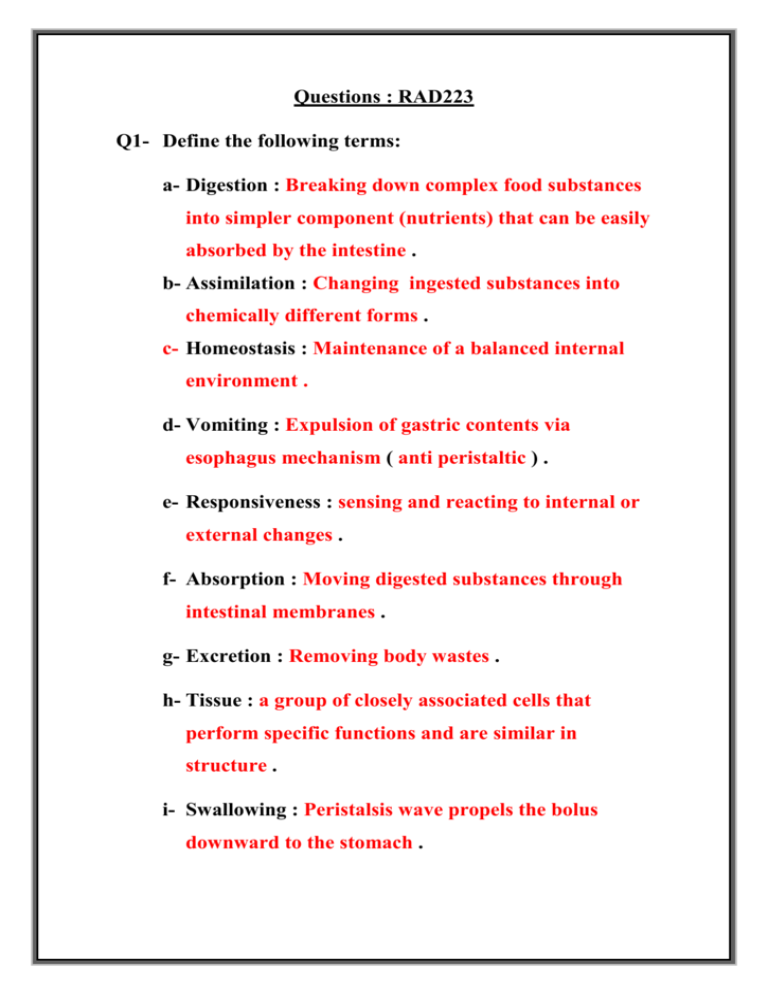
Questions : RAD223 Q1- Define the following terms: a- Digestion : Breaking down complex food substances into simpler component (nutrients) that can be easily absorbed by the intestine . b- Assimilation : Changing ingested substances into chemically different forms . c- Homeostasis : Maintenance of a balanced internal environment . d- Vomiting : Expulsion of gastric contents via esophagus mechanism ( anti peristaltic ) . e- Responsiveness : sensing and reacting to internal or external changes . f- Absorption : Moving digested substances through intestinal membranes . g- Excretion : Removing body wastes . h- Tissue : a group of closely associated cells that perform specific functions and are similar in structure . i- Swallowing : Peristalsis wave propels the bolus downward to the stomach . Q2- Write short notes about: a- Types of human tissues : l- Epithelial tissue – covering . 2- Connective Tissue – support . 3-Muscular Tissue – movement . 4-Nervous Tissue – sensation, motion, and control . b- Functions and components of the lymphatic system : Components : Lymphatic fluid and vessels , lymph nodes , tonsils , thymus , spleen . Functions : 1-Immunity, i.e. protection against microbes . 2-Returns proteins and fluid to blood. 3- carries lipids from GIT to the liver then to the blood . c- Importance of homeostasis : 1- A balanced internal environment needed to maintain life . 2- There are many complex mechanisms to maintain homeostasis . 3- The internal environment of the body is in a dynamic state of equilibrium, Chemical, thermal, and neural factors interact to maintain homeostasis . 4- Homeostatic mechanisms help regulate body temperature and blood pressure . 5- Homeostatic mechanisms act through feedback mechanism . d- Deglutition : 1- Soft palate: close nasal cavity . 2- Epiglottis: close larynx . 3-Posterior pillars of fauces: close mouth . 4- Respiration is temporary suspended . 5-Bolus reach esophagus . e- Control and functions of gastric juices : Functions : 1- Water : further liquefies food bolus . 2- HCL: kills microbes, acid environment help protein digestion . 3- Pepsins: digestion of proteins ►polypeptides (simpler amino acids) . 4- Mucus: protects mucosa . 5- Intrinsic factor: vitamin B12 absorption from ileum ( healthy mucosa ) . Control : 1-Cephalic phase: thought, smell or taste (vagus nerve) . 2- Gastric phase: proteins ► secretion of gastrin ► blood ►secretion of gastric juice . 3-Intestinal phase: acidic chyme in duodenum ►entrogastrone complex (secretin+ Cholecystokinin)► blood ► slow down secretion of gastric juice + stimulate secretion of pancreatic and bile juices . f- Functions and composition of bile : Function : 1-Reservoir ( Storage)for bile . 2-Concentration of bile; (after absorption of water) . 3-Release of stored bile.(contraction) . Composition : water, salts, pigments (bilirubin), mucus . g- Liver functions : 1-Carbohydrate metabolism: regulate blood glucose level . 2-Protein metabolism . 3-Lipid metabolism . 4-Synthesis and secretion of bile : emulsifying fats . 5-Detoxication: medications, ethanol, toxins . 6-Immunological Effects . 7-Storage: vitamins (fat-sol. & some water sol.) iron . h- General circulation (pathways). i- Name and role of different valves in the heart : 1- Mitral ( bicuspid ) : valve allow the passage of blood from left atrium to left ventricle and prevent flow back of the blood from the left ventricle to the left atrium . 2- Aortic : allow passage of the blood from the left ventricle to Aortic and prevent of the blood back flow from Aortic to left ventricle . 3- Pulmonary : allow passage from the blood from right ventricle to right pulmonary artery and prevent the blood back flow from right pulmonary to right ventricle . 4- Tricuspid : allow passage of the blood from the right atrium to right ventricle and prevent of the blood back flow from right ventricle to right atrium. Q3- Give reason why: a- Human body can't survive without oxygen : Oxygen is needed for oxidation and energy production . b- Stones are frequently formed in the salivary glands : Due to mineral content or because of saliva . c- Axial skeleton is protected during x-ray examinations :Due to the presence active bone marrow . d- Kidneys play a major role in homeostasis : 1- Maintain acid base balance . 2- Help regulate blood pressure . 3- Help regulate body temperature . 4- Help water in the body . 5- Electrolight balance . 6- Part of the system of blood formation . 7- Remove waste and toxin . e- Acute gastritis may lead to pernicious anemia : Because lack of internsing factor or interensing factor is not presence . f- Pancreas is a mixed gland : Because it has an endocrine and exocrine function . g- Arterial walls are rich with elastic fibers : To handle pulse pressure . h- Muscles along GIT are involuntary : Because continues movements are needed without being tired . i- Internal lining of the blood vessels are smooth : To avoid clot . Q4- Complete the following sentences: a- Endocrine glands includes Thyroid , Parathyroid , Pancreas , Ovaries , Testes , Adrenal glands . b- The most important excretory organs Skin , Kidney , Colon , Lungs , Liver . c- Lymph vessels usually run along next to veins to the heart . d- Male reproductive organs are Epididymis , Vas deferens , Penis , Testes . e- Female reproductive organs are fallopian tubes , uterus , vagina , ovaries . f- The 3 phases which control gastric juice secretions are cephalic phase , gastric phase , intestinal phase . g- Only water , alcohol and some sugar can be absorbed from the stomach. h- The types of movements along the small intestine segmental , pendular and peristalsis . i- The gall bladder help to Absorb , Fat and Fat soluble vitamin . j- The 4 layers forming the wall of the heart are Myocardium , Endocardium , Epicardium and Pericardium . Q5- Mark (√) true or (x) false then corrects the false one: a- Skin alone can regulate body temperature. ( F ) The answer : Skin can regulate body temperature . b- Muscles can help generating heat . ( T ) c- Liver is a part of the immune system . ( T ) d- Lung is a part of the excretory system . ( T ) e- Pyloric sphincter regulates passage of food from the esophagus to the stomach . ( F ) : The answer : from stomach to duodenum . f- Water soluble vitamins can't be absorbed without bile. ( F ) : The answer : Fat soluble vitamins can't be absorbed without bile . g- Gastro-colic reflex help to evacuate the stomach when we sleep . ( F ) : The answer : Gastro-colic reflex help to evacuate the stomach when we eat . h- Cholecystokinin enzyme helps secretion of bile from the liver when there is food in the stomach . ( F ) : The answer : Cholecystokinin enzyme helps secretion of bile from the liver when there is fat in the stomach . i- Insulin is secreted by the liver and drained by the pancreatic duct. ( F ) : The answer : Insulin is secreted by the pancreas and drained by the blood .
